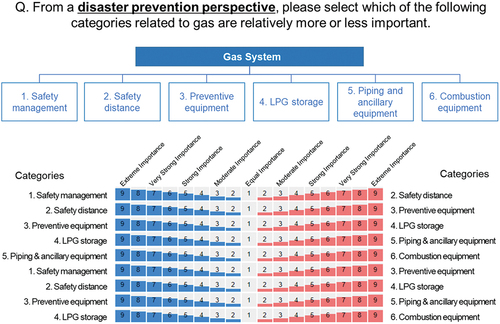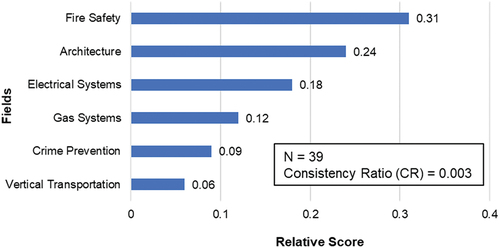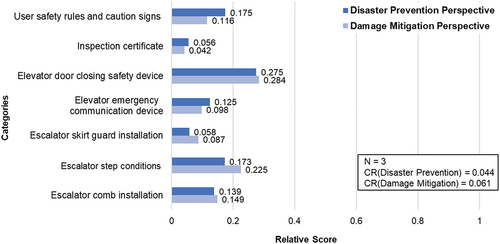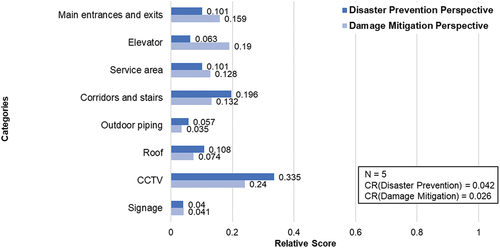ABSTRACT
Recognizing potential hazards is imperative for devising pragmatic building inspection and management strategies. However, existing safety evaluation standards across diverse fields have inherent limitations in ensuring overall building safety. Chained and cascading damages following a catastrophic disaster necessitate comprehensive safety management. Thus, this study derived evaluation criteria and determined their priority to assess building safety against various hazardous events in urban settings. This case study targeted Seoul’s public-use buildings with high risks of potential harm to many regular users. Moreover, this study aggregated evaluation categories from existing inspection and certification standards into field-specific groups, including architecture, fire safety, electrical systems, gas systems, vertical transportation, and crime prevention. This categorical evaluation was further analyzed based on their importance for preventing disasters and minimizing damage, emphasizing fire safety as the most essential for securing building safety. In addition, categories evaluated from a preventative perspective hold significantly greater importance than those focused on mitigating damage. This finding underscores the need for proactive monitoring and enhanced building safety across six fields before a disaster strikes. The integrated assessment method facilitates determining which areas are well managed or need improvement. Furthermore, this approach enables efficient building safety enhancement by prioritizing field-specific or evaluation criterion-specific areas.
1. Introduction
Hazardous disasters in buildings continually threaten citizen safety. Disaster event risks in buildings have intensified alongside rapid structure aging in developed countries. For example, aging building proportions (built over 30 years ago) have reached 41.0% in Seoul, Korea. This percentage is higher than the 37.1% national average and directly threatens occupant safety. Major cities worldwide, such as New York and Hong Kong, also face increasing concerns regarding aging structure safety. As of 2014, buildings within New York City averaged an age of 53 years (Bank of America, & Merrill Lynch, & CUF Citation2017). Similarly, over 30,000 buildings in Hong Kong were constructed 50 years ago and are projected to double by 2020 (Wong Citation2017). As aging buildings in urban areas are more vulnerable to various disasters, it is imperative to recognize hazardous event risks and devise pragmatic building inspection and management strategies, irrespective of the region.
Korea’s government and local authorities have recognized the need for building safety management and inspections to reduce vulnerability, and various measures have been proposed. However, the Ministry of Land, Infrastructure, and Transport; the Ministry of Public Administration and Security; and private organization dispersion complicate implementing these measures. Furthermore, domestic standards and evaluation systems for building safety management are fragmented across various fields, including architecture, seismic resilience, fire safety, electricity, vertical transportation (i.e., elevator and escalator), and crime prevention. These scattered evaluation standards have inherent limitations in ensuring comprehensive building safety against hazardous events that citizens might encounter.
Chained and cascading damages following a catastrophic disaster (e.g., building fire and electrical outages after a seismic event) also necessitate thoroughly managing overall building safety (Choi et al., Citation2018). Thus, this study derived evaluation criteria and their priority in assessing building safety against various hazardous events in urban settings. This case study targets public-use buildings in Seoul with a high risk of potential harm for many regular users. In 2018, the Seoul Metropolitan Government highlighted that the types of building-related accidents most likely to transpire are fire, collapse, electric shock, and elevator accidents, while earthquakes and flooding cause substantial damage.
The urgency for crime prevention in buildings is also surging due to recent rises in crimes and terrorist threats. Therefore, this research also defined architecture, fire safety, electrical systems, gas systems, vertical transportation (i.e., elevators and escalators), and crime prevention as evaluation fields to facilitate a thorough building safety assessment. The application scope was limited to public-use buildings defined by Article 17 of the Enforcement Decree of the Building Act, including cultural facilities, assembly facilities, religious facilities, sales facilities, passenger facilities, tourist accommodations, general hospitals, and buildings with more than 16 floors or a total floor area of more than 5,000 square meters. Historically, public-use buildings in Seoul have encountered various disasters and accidents, such as the Daeyoen-gak Hotel fire in 1971 (227 casualties) and the Sampoong Department Store collapse in 1995 (1,445 casualties).
The research methodology encompassed literature review, expert interviews, and expert surveys utilizing the Analytical Hierarchy Process (AHP). The literature review examined existing building safety inspection standards. Notably, this study analyzed evaluation items from the National Safety Inspection, Regular Safety Inspection for Public Structures, Building Maintenance and Management Inspection, Certification System for Seismic Building, Special Inspection for Fire Safety, and Crime Prevention Through Environmental Design certifications (CPTED) implemented during building safety inspections for public-use buildings in Korea.
Subsequently, the research consolidated the evaluation items employed in existing building safety standards for public-use buildings in Seoul categorized by building safety assessment fields. Expert opinions were then gathered to identify overlapping or omitted evaluation items for each field (architecture, fire safety, electrical systems, gas systems, vertical transportation, and crime prevention) and classify them based on relevancy and similarity. A survey among experts was conducted to analyze the importance of each evaluation category within the six fields based on pairwise comparison questionnaires and AHP analysis. Finally, this study presented practical applications and future research plans based on these results.
Comprehensive building safety assessments are possible with the proposed integrated evaluation criteria, and this categorization facilitates determining well-managed areas and those that require further improvement. This information provides efficient measures to enhance building safety, prioritizing criteria based on the overall safety evaluation results.
2. Literature review
Most domestic research has focused on assessing and enhancing building safety regarding earthquakes, fires, gas, vertical transportation, and crime. Heo et al. (Citation2009) proposed evaluation criteria for seismic safety, considering material and component characteristics in masonry buildings. For fire safety, Ham et al. (Citation2022) analyzed existing safety assessment models, derived new evaluation criteria, and assigned weights through expert surveys, focusing on five categories: industry risks, building safety, fire facility installations, fire hazard levels, and fire response status. This research proposed new managerial approaches to ensure more substantial fire safety and protection.
Concerning crime prevention, Lim and Lee (Citation2018) compared and analyzed cases overseas and existing crime prevention certification systems, providing preventative measures to address potential challenges when introducing a new certification system in Korea. Overall, domestic research has primarily evaluated individual field safety and lacks a comprehensive tool to assess the overall safety of existing public-use buildings. Similar to this research, the current study derived evaluation groups and items by analyzing similar existing systems or standards, reorganized items through expert opinions, and assigned weights based on their purpose.
Similar studies worldwide have also predominantly focused on evaluating safety during earthquakes and fire accidents, considering gas, electricity, and structural aspects as risk assessment items to design new proposals for safety assessment methods. Chen et al. (Citation2012) evaluated fire-related building safety by classifying safety evaluation items as fire prevention, evacuation and mitigation, and fire control and resistance. Their study referenced evaluation reports released by the National Fire Protection Association (NFPA), derived evaluation items through the Delphi method, and involved field experts. Mi et al. (Citation2020) also assessed existing building fire safety by classifying risk factors into disaster-causing factors (electricity, occupancy density, gas, etc.), passive measures (building’s fire resistance), active measures (fire-fighting facilities), property fire management, and the fire brigade’s rescue capability. Through expert surveys, they prioritized risk factors using the triangular fuzzy judgment matrix. In addition, Yang et al. (Citation2012) assessed underground building fire safety by assigning scores for evaluation items in fire-proof capacities, fire-fighting capacities, evacuation systems, and fire safety management through grey relational analysis. Regarding earthquakes, Ilki and Celep (Citation2012) proposed a quantitative safety assessment of reinforced concrete structures based on building usage, structure, seismic loads, height, and ground type by assigning coefficients. Lupășteanu et al. (Citation2022) also designed a building condition assessment in Romania, focusing on structural and non-structural damages for inspection.
Such studies have identified limitations in creating a unified method to evaluate the overall safety of public-use buildings. Instead, these studies utilized existing evaluation methods presented by organizations such as NFPA and reanalyzed item importance through expert opinions. Although Hong Kong has attempted to implement a mandatory building inspection scheme for aged buildings, including fire safety, structural and external building elements, and drainage systems, this scheme placed greater emphasis on evaluating obsolescence rather than building disaster management (Chan Citation2019; Chan et al. Citation2014). A recent study on building information systems focused on technical performance by evaluating plumbing and HVAC system maintenance defects, not disaster risk mitigation.
Until now, building safety evaluation research and methods have incorporated limited safety considerations in several relevant fields, making obtaining essential safety information from other fields challenging. However, Lo (Citation1999) claimed that appraising the building’s comprehensive safety status is crucial for evaluating even a single safety issue (e.g., building fire) due to the complex nature of disasters and chained damage, highlighting the importance of a thorough understanding of overall building safety. Therefore, this study distinguishes itself by offering integrative and comprehensive evaluation criteria for six vital disaster risk prevention and mitigation fields in contrast to previous research.
3. Research methods
Approximately 61 potential disaster types could occur in Seoul at any time (Seoul Metropolitan Government Citation2018). These hazardous event risks are classified into high, medium, or low levels according to their occurrence likelihood and consequence or damage scale. Disaster types such as building collapses, electrocution accidents, elevator accidents, severe life-threatening crimes, and fires are highly likely to occur in buildings in Seoul (Seoul Metropolitan Government Citation2018). Although the occurrence likelihood is lower, flooding, inundation, and earthquakes are disaster types that cause considerable building damage (Seoul Metropolitan Government Citation2018). After the final discussion with the Seoul City Government’s disaster management office, the safety evaluation fields in this study include architecture, fire safety, electrical systems, gas systems, vertical transportation, and crime prevention.
3.1. Defining evaluation criteria
Various standards, systems, and evaluations have been established in Korea to inspect overall building safety, including the National Safety Inspection, Regular Safety Inspection for Public Structures, and Building Maintenance and Management Inspection. Additionally, there are certification systems for specific building performances, such as the Certification System for Seismic Building, Special Inspection for Fire Safety, and Crime Prevention Design Certification Systems. The evaluation fields for each system are presented in .
Table 1. Existing standards and literature regarding safety evaluation.
Relevant content from existing systems were aggregated to organize imperative evaluation categories in architecture, fire safety, electrical systems, gas systems, vertical transportation, and crime prevention. In addition to the domestic standards in Korea, NFPA codes and standards, various codes from the International Code Council, and additional literature were reviewed.
For architecture, 31 evaluation categories were derived from relevant standards and the literature review (Chan Citation2019; Ilki and Celep Citation2012; Lupășteanu, Lupășteanu, and Chingălată Citation2022). Fire safety included 43 categories, encompassing the most evaluation categories among the six fields. Electrical system evaluation categories were extracted and aggregated, resulting in 22 categories (Kaleh, Mohammadian, and Pouyakian Citation2021; Khalil, Kamaruzzaman, and Baharum Citation2016). Additionally, seven categories were collected regarding gas systems and vertical transportation utilized eight categories. Lastly, crime prevention was divided into seven categories based on CPTED certification evaluation items (Cozens and Love Citation2015; Piety Citation2019).
After aggregating the evaluation categories, expert opinions were sought in each field to confirm each category’s suitability. In addition, 10 field experts were interviewed to extract items that were difficult to apply to Seoul’s public-use buildings or required reclassification and integration to enhance safety evaluation efficacy. Results reflecting the experts’ opinions are presented in .
Table 2. Restructured evaluation fields for integrative building safety.
Regarding architecture, specific categories were separated into parent groups based on similarities. The first group, “safety management status,” comprises categories focused on investigating building safety management implementation and degree. The second group, “general architectural information,” provides fundamental information and related building details to compare the building’s initial purpose, condition, and current status. Third, “structural integrity” presents categories that assess the building’s structural safety, including the foundation, structure, retaining walls, and seismic performance. Lastly, the “architectural finishes” categories concern the roof, rooftop finishes, their utilization, and finishes for the building’s interior and exterior.
Due to the fire safety field’s extensive detailed categories, this study focused on efficiently integrating similar categories. For instance, categories such as “warning facilities,” “evacuation facilities,” “evacuation fire facilities,” and “adequate slopes for bed evacuation” were integrated into the “alarm & evacuation facilities” group. Similar to the architectural field, a high relevance among categories was observed in the fire safety field; thus, they were integrated into three parent groups: “fire safety (general),” “fire safety (architecture),” and “fire safety (facilities).” The “fire safety (general)” group included general aspects, such as the regular inspection and building maintenance, and characteristics of subjects using and managing these buildings. The “fire safety (architecture)” group evaluated architectural elements (spaces, openings, structures, materials, etc.) closely related to fire safety, including fire facilities, evacuation facilities, fire-resistant structures, and finishes. Finally, the “fire safety (facilities)” group considered equipment, devices, and environmental conditions related to fire suppression, warning/evacuation facilities, and fire handling facilities to combat fires and prevent damage from spreading.
Regarding electrical systems, categories related to cables, switches, and wiring were categorized into “safety management,” “incoming,” “distribution board,” and “facilities & equipment” groups based on their similarities. The experts agreed that some evaluation criteria in the existing standards, such as pressure regulators for city gas, could be removed due to their nominal impact on disaster response
After integrating similar categories within the six fields and removing categories with low relevance to disasters in public-use buildings in Seoul, categories were reduced from 112 to 58, enabling efficient evaluation procedures.
3.2. Determining evaluation category importance
The AHP analysis method was used to assign weights by comparing the importance of within-field evaluation categories and the six evaluation fields. The AHP constitutes a measurement theory that incorporates pairwise comparisons and relies on professional expertise to establish priority scales (Alexander Citation2012; Bunruamkaew Citation2014; Khalil, Kamaruzzaman, and Baharum Citation2016; Saaty Citation1990). Within AHP’s framework, all criteria or parameters were assigned weight scores indicating each criterion’s significance. AHP methodology has been widely employed for built environments as a decision-making tool (Ali et al. Citation2010; Z. Chen et al. Citation2006; Hsieh, Lu, and Tzeng Citation2004; Khalil, Kamaruzzaman, and Baharum Citation2016; Poveda and Lipsett Citation2011). Among various methodologies, this research employed AHP to assess the significance of different items. AHP was chosen for its superior effectiveness in multicriteria decision-making compared to other methods in within-field evaluation categories and the six evaluation fields. In addition, it facilitates decision-making in situations where multiple interrelated and sometimes conflicting criteria pertain to building safety. Among the previously proposed evaluation criteria, AHP aids in establishing priorities among decision criteria within the context of decision-making (Darko et al. Citation2019; Shapira and Goldenberg Citation2005). Surveys were conducted based on expert opinions to assess field and evaluation category importance for the integrated safety assessment of public-use buildings in Seoul. The criteria for measuring safety assessment category importance was established based on each field’s and category’s preventative (before accidents) and mitigation (after accidents) effects. Individuals were asked to indicate importance using a scale from 1 (equal importance) to 9 (extreme importance) based on the AHP scale of importance (Saaty Citation1990).
During the survey, experts used a 1:1 pairwise comparison to determine the prominence of each decision element (i.e., evaluation category) relative to another. Results were calculated as each element’s weight using the eigenvalue method. The distributive mode was used to derive the relative importance between safety evaluation categories and assigned weights (importance) to compare subjects proportionally to their relative importance ratios, ensuring that the weighted sum equaled 1.
Furthermore, the logical consistency of decision-maker judgments made during pairwise comparisons was evaluated by analyzing the inconsistency ratio. If the ratio exceeded 0.1, the logical consistency was considered insufficient; reviewing the pairwise comparison results to adjust illogical judgments was necessary in such cases. Finally, eigenvalues from all pairwise comparison matrices were calculated, and pairwise comparison results were integrated to derive priority and importance among alternatives based on criteria.
The survey incorporated academia and industry experts (e.g., universities, associations, construction companies, and safety consulting firms) engaged in architecture, fire safety, electrical systems, gas systems, vertical transportation, and crime prevention. The survey was conducted face-to-face or through written methods with 39 respondents (six architecture, nine fire safety, eight electrical systems, eight gas systems, three vertical transportation, and five crime prevention experts). First, each respondent was introduced to the survey’s purpose and the AHP process. The experts were instructed to assess the relative importance between indicators and assign a score on the importance scale for each. This assessment was achieved using a scale from 1 to 9, as outlined in . provides a questionnaire example that respondents were required to answer.
Participant responses were verified based on logical consistency before integrating survey results from pairwise comparisons. AHP analysis automatically detects the logical consistency of a respondent’s judgment; thus, logical consistency can be verified when there are three or more comparison subjects for a specific criterion. The logical consistency of the respondent’s judgment was considered insufficient if the consistency ratio (CR) exceeded 0.1. CRs among respondents and each field/category were analyzed; all collected survey responses had CRs below 0.1, verifying the data’s logical consistency.
4. Results
The professional opinions of 39 experts revealed that among the six evaluation fields in the comprehensive safety management of Seoul’s public-use buildings, fire safety management held the highest importance, followed by architecture, electrical systems, gas systems, crime prevention, and vertical transportation ().
The analysis of evaluation category importance within the fire safety field is presented in . Regarding disaster prevention, experts agreed that general fire safety (M = 0.501) should have the highest importance, followed by architecture (M = 0.285) and facility (M = 0.215) fire safety. Among the categories, experts responded that inspection and maintenance (M = 0.641) information is the most crucial for preventing fire disasters in advance. Evaluation items included within the inspection and maintenance category encompass appointed fire safety manager suitability (appointment grade), fire safety manager qualifications, fire plan establishment and execution of tasks, execution of self-inspections in fire facilities, inspection status of safety facilities in public-use premises (detailed checklist completion), record retention, execution of internal fire safety education and training, and joint fire training with fire stations.
Figure 3. Relative fire safety field importance: (a) Between parent groups and (b) Between categories.
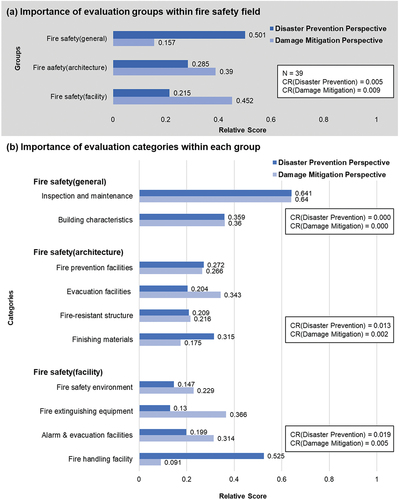
Alternatively, the facility fire safety group (M = 0.452) directly related to fire suppression and evacuation was found to have a higher importance than the other two groups in minimizing fire disaster damages. Among evaluation categories within the facility fire safety group, the importance of fire extinguishing equipment (M = 0.366) was highest, followed by alarm and evacuation facilities (M = 0.314) and the fire safety environment (M = 0.229). Within the architecture fire safety group, evacuation facility availability and adequacy (M = 0.343) were highlighted as crucial factors for minimizing post-fire damages. However, experts assigned categories related to building characteristics (M = 0.360), finishing materials (M = 0.175), and fire handling facilities (M = 0.091) the lowest importance for minimizing fire damages in each respective group.
In the architecture field, which was identified as the second most important field, the structural integrity group (M = 0.411) was the most crucial aspect in preventing disasters such as collapses (). This group was followed by safety management status (M = 0.380), general architectural information (M = 0.150), and architectural finishes (M = 0.059). Within the structural integrity group, tilting (M = 0.247) was deemed the most imperative category for accident prevention. This criterion evaluates smooth window operation, no tilting of floors, and exterior wall vertical states. Live load alteration, which indicates whether unauthorized structures or tanks have been installed on roofs or within buildings (M = 0.177), was identified as the second most important. On the other hand, within the architectural finishes group, interior and exterior finishing conditions (M = 0.174) were the least important for accident prevention. Minimizing damage from disasters/accidents was also evaluated, and the order of importance was structural integrity (M = 0.420), safety management status (M = 0.402), general architecture (M = 0.102), and architectural finishes (M = 0.076).
Figure 4. Relative architecture field importance: (a) Between parent groups and (b) Between categories.
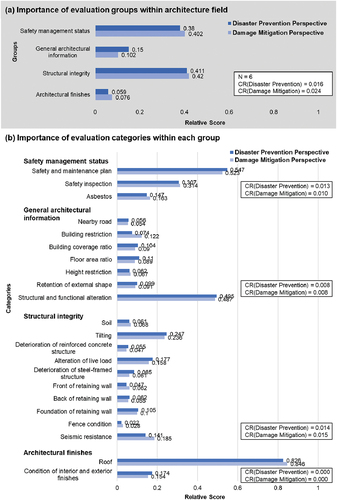
As shown in , experts responded that for disaster prevention concerning electrical systems, the safety management (M = 0.521) group is more vital than the facilities & equipment (M = 0.218), distribution board (M = 0.159), and incoming (M = 0.101) groups. Evaluation categories within the safety management group include whether electrical safety manager appointments and duties are carried out and if legal inspections (checks) are conducted following domestic laws. Mechanical equipment use, such as electric heaters (M = 0.316), was identified as the most important category for disaster prevention within the facilities & equipment group, while emergency power generation equipment (M = 0.052) was the least important.
Figure 5. Relative electrical systems field importance: (a) Between parent groups and (b) Between categories.
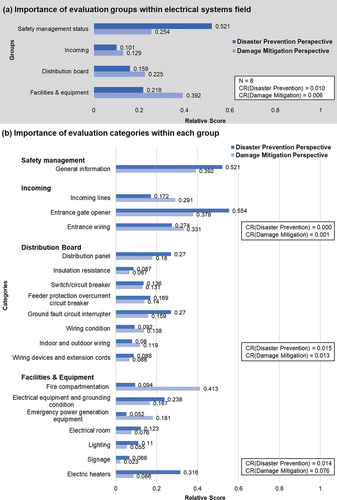
The facilities & equipment (M = 0.392) group achieved the highest importance for minimizing disaster damage, followed by safety management (M = 0.254), distribution board (M = 0.225), and incoming (M = 0.129). The category with the highest importance was fire compartmentation (M = 0.413), while signage and lighting (M = 0.023) had the least importance.
As presented in , experts rated the combustion equipment category (M = 0.297) as the most important in the gas systems field, followed by safety management (M = 0.210) and piping and ancillary equipment (M = 0.210). Evaluation items within the combustion equipment category include boiler and water heater installation, exhaust material suitability, open combustion system installation, forced exhaust system installation status, and using inspected or KS-certified gas appliances. The experts added that appropriate installation conditions and materials allow proper management and help prevent gas-related accidents. For minimizing accident damage, experts rated the piping and ancillary equipment (M = 0.222) category as the most important, followed by safety management (M = 0.169) and preventive equipment (M = 0.160). Specific evaluation items within the piping and ancillary equipment category include intermediate valve suitability (fuse cocks) and hose installation, piping fixation status, and gas leakage status.
The analysis of evaluation category importance in the vertical transportation field, including elevators and escalators, is shown in . Experts rated the operation status of elevator door-closing safety devices (M = 0.275) as the most important category for disaster prevention. They also designated importance in the following order: user safety rules and caution signs (M = 0.175) and escalator step conditions (M = 0.173).
Experts also concluded that the operation status of elevator door-closing safety devices (M = 0.284) is the most imperative for minimizing disaster damage. Meanwhile, attaching inspection certificates were assessed as the least important for disaster prevention (M = 0.056) and minimizing disaster damage(M = 0.042).
As shown in , experts considered CCTV (M = 0.335) as the most influential for crime prevention, followed by corridors and stairs (M = 0.196), the roof (M = 0.108), and main entrances and exits (M = 0.101). Evaluation items within the CCTV category include installing CCTV or emergency alarms in less populated areas, installing products with appropriate resolutions, monitoring, recording storage, and establishing operation guidelines. For minimizing criminal damages, experts also rated CCTV (M = 0.240) as the most important, followed by elevators (M = 0.190) and main entrances and exits (M = 0.159). Signage and outdoor piping categories were determined as the least important in crime prevention and minimizing crime-related damages.
To summarize aforementioned results, presents the comprehensive analysis encompassing the importance of all evaluation categories within the six fields regarding disaster prevention (marked with an asterisk (*) and damage mitigation. It is evident that the categories related to disaster prevention are consistently ranked higher across all evaluation fields when compared to those associated with damage mitigation.
Table 3. Overall evaluation category importance within each field.
5. Discussion
This study redefined evaluation categories for assessing the overall safety of public-use buildings in Seoul while considering architecture, fire safety, electrical systems, gas systems, vertical transportation, and crime prevention. Individual category weights were established by analyzing relative importance. The analysis results emphasized that fire safety and architecture fields maintained the most substantial inspection importance among the six fields. Overall, categories prioritizing preventative measures achieved significantly greater importance than those focused on mitigating damage. This finding accentuates the value of consistently monitoring and enhancing building safety across all six fields before a disaster strikes to avert potential incidents. The analysis results closely align with the disaster management paradigm shift within academic and industrial spheres, highlighting the increasing emphasis on proactive measures for disaster prevention and damage mitigation. For instance, it is more important to prevent fire disasters than to minimize fire disaster damages, excluding fire extinguishing and emergency power equipment categories. Furthermore, consistently providing information related to inspection and maintenance is crucial for preventing fire disasters. For proactive disaster management, an overall safety management plan must include a checklist to ensure equipment, safety devices, and communication device conditions in electricity, gas, and vertical transportation fields. CCTV installation and operation must be the top priority for crime prevention while ensuring safety in corridors, stairs, rooftops, and main entrances.
The main contribution of this study is to provide a comprehensive safety assessment that considers complex disasters, chained and cascading damage, and disaster management stages. This assessment facilitates identifying which safety management fields and detailed items are more imperative at which disaster management phase. The present study’s findings can serve as valuable guidance for building safety managers, helping them identify initial priorities for disaster management measures and determine where to allocate managerial resources (e.g., finances, time, and workforce) most effectively. In addition, these results could be presented as a safety inspection checklist, enabling safety assessment measurements for each field while considering evaluation outcomes and individual weights.
This study’s outcomes can be used for integrated safety building management, as shown in . Traditionally, building safety inspection methods have faced challenges simultaneously obtaining safety information from different fields. For instance, a seismic safety certification might not guarantee building safety for occupants in other aspects, such as fire or violent crimes. However, the proposed method allows simultaneous assessment of well-managed areas and those that require improvement (, left).
Furthermore, if an individual building’s comprehensive evaluation data is collected and managed at a city-wide level, this data could be utilized to analyze overall building management status and limitations throughout the city. In addition, these findings could resolve challenges from current evaluation methods where building owners or managers evaluate safety aspects separately. This data would then contribute to forming relevant policies and regulations for building safety management at the city level. First, the suggested evaluation criteria and their respective significance can be presented as a checklist both before and after the construction project to be disseminated from the local government to the building owner. This approach ensures that the building owner and project participants collectively grasp the crucial aspects of safety management, which eliminates the need to cross-reference diverse safety requirements from various fields. Moreover, within urban planning and policy-making, the integrated evaluation list will facilitate greater collaboration among diverse field experts. This comprehensive list encompasses the entire spectrum of criteria for assessing building safety, making it easy for experts from various fields to share their insights and obtain the same from other disciplines.
The enhancement from this study aligns with fundamental integrated safety management processes that involve defining work scope, analyzing hazards, developing and implementing hazard controls, performing work, and obtaining feedback and improvement (Bump Citation1999). These improvements directly enhance execution, feedback, and improvement stages, establishing a foundation for integrated building safety management (Bump Citation1999).
6. Conclusions
Individual inspection and certification systems for building safety face limitations in assessing overall public-use building safety in Seoul. Therefore, this case study aggregated evaluation categories from existing inspection and certification standards into field-specific groups, including architecture, fire safety, electrical systems, gas systems, vertical transportation, and crime prevention. These evaluation categories were further analyzed based on their importance for preventing disasters/accidents and minimizing damage.
Based on expert surveys and AHP analysis, this study revealed that the fire safety domain holds the highest significance concerning building disaster safety management. Additionally, across all six areas, experts agreed that prioritizing the prevention of potential disasters is of greater importance than mitigating damage post-disaster. The resulting importance and weights established for these categories can be utilized to derive field-specific safety assessments based on a safety inspection checklist. This research’s most significant contribution lies in offering a comprehensive building safety assessment across six domains. Furthermore, this assessment considers complex disasters, chained damage, and disaster management phases rather than being confined to a single specific field. In addition, the integrated assessment facilitates determining which areas are well managed or require improvement. When time or resources for comprehensive facility inspections are limited, this approach allows efficient building safety enhancement by prioritizing field-specific or evaluation criterion-specific areas.
However, this research acknowledges its limitations and recognizes the need for future studies to improve its applicability in subsequent research endeavors. First, establishing detailed evaluation methods and criteria for individual indicators and reaching a final decision is crucial for applying the results of this study in assessing public-use building safety in Seoul. For example, the criteria for each evaluation item must be defined (e.g., satisfactory, cautious, unsatisfactory) based on detailed evaluation methods and standards. Given the potential variations in expertise among the individuals in charge, future research should develop comprehensive and user-friendly guidelines for assessing each criterion. Additionally, final evaluation indicators must be applied to actual public-use buildings for comparison and validation against existing certification systems for inspection procedures and evaluation presentations in the future. Adjusting evaluation item weights is also necessary owing to variations in hazards and building status. Lastly, future work should consider different cities worldwide for a comprehensive building safety evaluation that covers various regions while reflecting their common or specific disaster characteristics and other building types (e.g., residential buildings).
Acknowledgements
This work was supported by the Technology Innovation Program (20019382, AI Technology for Analyzing Fire Engines’ Accessibility to Fire Site) funded by the Ministry of the Interior and Safety (MOIS, Korea) and the Seoul Metropolitan Government. This study was carried out with the support of ‘R&D Program for Forest Science Technology (Project No. 2023480C10-2325-AA01)’ provided by Korea Forest Service (Korea Forestry Promotion Institute). This work was supported by INHA UNIVERSITY Research Grant.
Disclosure statement
No potential conflict of interest was reported by the author(s).
Additional information
Funding
Notes on contributors
Sungjoo Hwang
Dr. Sungjoo Hwang is an associate professor at Ewha Womans University and received a Ph.D. in Architectural Engineering at Seoul National University, Korea. Dr. Hwang’s current research interest centers on urban systems and infrastructure management using information and communication technologies (ICTs) to ensure our safety, health, and quality of life.
Minji Choi
Dr. Minji Choi holds the position of Assistant Professor within the Department of Architectural Engineering at Inha University, Korea. Dr. Choi’s research endeavors are centered on the critical task of managing and improving safety within the built environment, with particular emphasis on the well-being of construction workers and facility occupants.
References
- Alexander, M. 2012. Decision-Making Using the Analytic Hierarchy Process (AHP) and SAS/IML, 1–12. Baltimore, MD: Social Security Administration.
- Ali, A. S., S. N. Kamaruzzaman, R. Sulaiman, and Y. Cheong Peng. 2010. “Factors Affecting Housing Maintenance Cost in Malaysia.” Journal of Facilities Management 8 (4): 285–298. https://doi.org/10.1108/14725961011078990.
- Arghami, S., K. Kamali, and M. Mahboubi. 2016. “Development of a Fire Safety Checklist for Dormitories.” Journal of Human Environment and Health Promotion 2 (1): 20–31. https://doi.org/10.29252/jhehp.2.1.20.
- Bank of America, & Merrill Lynch, & CUF. March 2, 2017. “Average Age of New York City Infrastructure As of 2014 (In Years) [Graph].” Statista. Accessed July 31, 2023, from https://www.statista.com/statistics/724427/new-york-average-age-of-infrastructure/.
- Bump, S. L. 1999. Integrated Safety Management System (ISMS) Program Description (No. HNF-5220, Rev. 0). BWHC (US).
- Bunruamkaew, K. 2014. “How to Do AHP Analysis in Excel.” 2012.
- Chan, D. W. 2019. “Sustainable Building Maintenance for Safer and Healthier Cities: Effective Strategies for Implementing the Mandatory Building Inspection Scheme (MBIS) in Hong Kong.” Journal of Building Engineering 24:100737. https://doi.org/10.1016/j.jobe.2019.100737.
- Chan, D. W., H. T. Hung, A. P. Chan, and T. K. Lo. 2014. “Overview of the Development and Implementation of the Mandatory Building Inspection Scheme (MBIS) in Hong Kong.” Built Environment Project and Asset Management 4 (1): 71–89. https://doi.org/10.1108/BEPAM-07-2012-0040.
- Chen, Y. Y., Y. J. Chuang, C. H. Huang, C. Y. Lin, and S. W. Chien. 2012. “The Adoption of Fire Safety Management for Upgrading the Fire Safety Level of Existing Hotel Buildings.” Building and Environment 51:311–319. https://doi.org/10.1016/j.buildenv.2011.12.001.
- Chen, Z., D. Clements-Croome, J. Hong, H. Li, and Q. Xu. 2006. “A Multicriteria Lifespan Energy Efficiency Approach to Intelligent Building Assessment.” Energy and Buildings 38 (5): 393–409. https://doi.org/10.1016/j.enbuild.2005.08.001.
- Choi, M., R. Starbuck, S. Lee, S. Hwang, S. Lee, M. Park, and H. S. Lee. 2018. “Distributed and Interoperable Simulation for Comprehensive Disaster Response Management in Facilities.” Automation in Construction 93:12–21.
- Cozens, P., and T. Love. 2015. “A Review and Current Status of Crime Prevention Through Environmental Design (CPTED).” Journal of Planning Literature 30 (4): 393–412. https://doi.org/10.1177/0885412215595440.
- CPTED Research Information Center. 2023. “Crime Prevention Design Certification in Korea.” http://www.cpted.kr/.
- Darko, A., A. P. C. Chan, E. E. Ameyaw, E. K. Owusu, E. Pärn, and D. J. Edwards. 2019. “Review of Application of Analytic Hierarchy Process (AHP) in Construction.” International Journal of Construction Management 19 (5): 436–452. https://doi.org/10.1080/15623599.2018.1452098.
- Ham, T., K. Shim, S. Kim, and W. Song. 2022. “A Study on the Building Fire Safety State Index for the Establishment of Safety State Information Map.” Journal of the Korea Academia-Industrial Cooperation Society 23 (10): 384–392. https://doi.org/10.5762/KAIS.2022.23.10.384.
- Heo, J., and S. Lee. 2009. “Analytical Study on the Seismic Capacity for Existing Masonry Building in Korea.” Journal of the Korea Institute for Structural Maintenance and Inspection 13 (6): 75–87.
- Hsieh, T. Y., S. T. Lu, and G. H. Tzeng. 2004. “Fuzzy MCDM Approach for Planning and Design Tenders Selection in Public Office Buildings.” International Journal of Project Management 22 (7): 573–584. https://doi.org/10.1016/j.ijproman.2004.01.002.
- Ilki, A., and Z. Celep. 2012. “Earthquakes, Existing Buildings and Seismic Design Codes in Turkey.” Arabian Journal for Science and Engineering 37 (2): 365–380. https://doi.org/10.1007/s13369-012-0183-8.
- International Code Coucil. 2021. “2021 International Building Code (IBC).” https://codes.iccsafe.org/content/IBC2021P2.
- The International Crime Prevention Through Environmental Design Association. 2010. “CEN/TC 325 - Crime Prevention Through Building, Facility and Area Design.” https://www.cpted.net/.
- Kaleh, H., F. Mohammadian, and M. Pouyakian. 2021. “Developing a Safety Audit Checklist for In-Operation Administrative Buildings.” Work 70 (3): 785–794. https://doi.org/10.3233/WOR-205011.
- Khalil, N., S. N. Kamaruzzaman, and M. R. Baharum. 2016. “Ranking the Indicators of Building Performance and the users’ Risk via Analytical Hierarchy Process (AHP): Case of Malaysia.” Ecological Indicators 71:567–576. https://doi.org/10.1016/j.ecolind.2016.07.032.
- Korea Authority of Land & Infrastructure Safety. 2023. “Certification System for Seismic Building in Korea.” https://www.kalis.or.kr/.
- Lim, D., and K. Lee. 2018. “Comparative Analysis of Building Certification System for Introducting Crime Prevention Through Environmental Design Certification in Korea.” Journal of the Korean Housing Association 29 (1): 1–9. https://doi.org/10.6107/JKHA.2018.29.1.001.
- Lo, S. M. 1999. “A Fire Safety Assessment System for Existing Buildings.” Fire Technology 35 (2): 131–152. https://doi.org/10.1023/A:1015463821818.
- Lupășteanu, V., R. Lupășteanu, and C. Chingălată. 2022. “Condition Assessment of Buildings in Romania: A Proposed Method and Case Study.” Journal of Building Engineering 47:103814. https://doi.org/10.1016/j.jobe.2021.103814.
- Mi, H., Y. Liu, W. Wang, and G. Xiao. 2020. “An integrated method for fire risk assessment in residential buildings.” Mathematical Problems in Engineering 2020:1–14. https://doi.org/10.1155/2020/9392467.
- Ministry of Land, Infrastructure and Transport. 2011. “A Guidline for Regular Safety Inspection for Public Structures. Ministry of Land, Infrastructure and Transport, Korea.” https://www.molit.go.kr/.
- Ministry of Land, Infrastructure and Transport. 2013. “A Manual for Building Maintenance and Management Inspection in Korea. Ministry of Land, Infrastructure and Transport, Korea.” https://www.molit.go.kr/
- Ministry of Science and ICT. 2019. “National Safety Inspection in Korea Check List. Ministry of Science and ICT, Korea.” https://www.msit.go.kr/.
- National Fire Agency. 2020. “Evaluation Criteria for Special Inspection for Fire Safety in Korea. National Fire Agency, Korea.” https://www.nfa.go.kr/nfa/.
- National Fire Protection Association. 2023. “Standard for Integrated Fire Protection and Life Safety System Testing.” https://www.nfpa.org/codes-and-standards/all-codes-and-standards/list-of-codes-and-standards/detail?code=4.
- Piety, E. T. 2019 Crime Prevention Through Environmental Design (CPTED) Checklist Directions - Section 1.0 Natural Surveillance. Federal Way, Washington: United States of America. Accessed March 11, 2024. CID: 20.500.12592/r5tr2z. https://policycommons.net/artifacts/2635167/crime-prevention-through-environmental-design-cpted-checklist-directions/3658048/.
- Poveda, C. A., and M. G. Lipsett. 2011. “A Review of Sustainability Assessment and Sustainability/Environmental Rating Systems and Credit Weighting Tools.” Journal of Sustainable Development 4 (6): 36. https://doi.org/10.5539/jsd.v4n6p36.
- Saaty, T. L. 1990. “How to Make a Decision: The Analytic Hierarchy Process.” European Journal of Operational Research 48 (1): 9–26. https://doi.org/10.1016/0377-2217(90)90057-I.
- Seoul Metropolitan Government. 2018. Safety City Seoul Plan.
- Shapira, A., and M. Goldenberg. 2005. “AHP-based equipment selection model for construction projects.” Journal of Construction Engineering and Management 131 (12): 1263–1273. https://doi.org/10.1061/(ASCE)0733-9364(2005)131:12(1263).
- Wong, R. 2017. “Hong Kong’s Rising Number of Aged Buildings Need Facelifts.” South China Morning Post. Accessed July 31, 2023, from https://www.scmp.com/property/hong-kong-china/article/2104785/hong-kongs-rising-number-aged-buildings-need-facelifts?module=perpetual_scroll_0&pgtype=article&campaign=2104785.
- Yang, F., X. Qian, and P. Huang. 2012. “Fire Safety Assessment of Underground Buildings Based on Grey Relational Analysis.” Procedia Engineering 45:89–95. https://doi.org/10.1016/j.proeng.2012.08.126.

